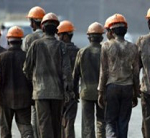Indian economy’s excessive dependence on a single fuel (coal) for power generation and on a single company (Coal India) for supplying that fuel has created a huge risk. Coal India’s unions threatened a five-day strike, thankfully called off after a day, to “denounce moves towards commercial mining of the fuel”.
This strike would have been disastrous for India’s power sector and in turn the economy, which relies on coal for over 80% of its electricity generation. The Central Electricity Authority keeps a tab on fuel stocks of 100 coal fired power plants with a total capacity of 114,000 mw. These plants are supposed to have 21 days of fuel stocks—actual stock is nine days because of problems with mining and logistics (Railways). 42 of these plants have coal stocks of less than seven days, and 20 of these have coal stocks of less than four days. Hence, the threat of the five day strike (from January 6-10) if carried through, would have seriously hurt electricity generation across the country.
This is, to say it simply, hostage-taking by the unions which don’t want to see their power erode. Happy new year from BMS (Bharatiya Mazadoor Sangh), INTUC (Indian National Trade Union Congress), CITU (Centre of Indian Trade Unions), AITUC (All India Trade Union Congress) and HMS (Hind Mazdoor Sabha)!
As of today, the private sector’s presence in coal mining is minimal, and is likely to remain so given the events of the past few years i.e. the Supreme Court’s cancellation of coal block allocation made during the UPA regime. Short term mitigation of the union threat could be by importing more of liquefied natural gas (LNG) and running the 22,000 mw of natural gas fired power plants which are operating at very low loads. Luckily for us, LNG prices in the international market have fallen in the past few months and India has the infrastructure to scale up imports.
A longer term solution will be to let other government firms—NTPC (National Thermal Power Corporation), SAIL (Steel Authority of India Limited) and NMDC (National Mineral Development Corporation)—into coal mining. This move would diversify dependence and check the various worker unions’ gripe against the entry of private sector—surely, they can’t protest against a sister public sector firm mining coal for captive consumption.
The Centre also needs to fast track investments in hydropower—in India as well as in Nepal and Bhutan. Apart from diversifying the power base, a dam is less vulnerable to fuel supply disruptions.
India’s economy cannot be held hostage.
Amit Bhandari is Fellow, Energy & Environment Studies, Gateway House.
This blog was exclusively written for Gateway House: Indian Council on Global Relations. You can read more exclusive content here.
For interview requests with the author, or for permission to republish, please contact outreach@gatewayhouse.
© Copyright 2015 Gateway House: Indian Council on Global Relations. All rights reserved. Any unauthorized copying or reproduction is strictly prohibited.


